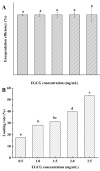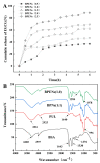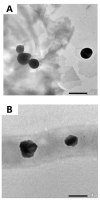The Loading of Epigallocatechin Gallate on Bovine Serum Albumin and Pullulan-Based Nanoparticles as Effective Antioxidant
- PMID: 36553816
- PMCID: PMC9777656
- DOI: 10.3390/foods11244074
The Loading of Epigallocatechin Gallate on Bovine Serum Albumin and Pullulan-Based Nanoparticles as Effective Antioxidant
Abstract
Due to its poor stability and rapid metabolism, the biological activity and absorption of epigallocatechin gallate (EGCG) is limited. In this work, EGCG-loaded bovine serum albumin (BSA)/pullulan (PUL) nanoparticles (BPENs) were successfully fabricated via self-assembly. This assembly was driven by hydrogen bonding, which provided the desired EGCG loading efficiency, high stability, and a strong antioxidant capacity. The encapsulation efficiency of the BPENs was above 99.0%. BPENs have high antioxidant activity in vitro, and, in this study, their antioxidant capacity increased with an increase in the EGCG concentration. The in vitro release assays showed that the BPENs were released continuously over 6 h. The Fourier transform infrared spectra (FTIR) analysis indicated the presence of hydrogen bonding, hydrophobic interactions, and electrostatic interactions, which were the driving forces for the formation of the EGCG carrier nanoparticles. Furthermore, the transmission electron microscope (TEM) images demonstrated that the BSA/PUL-based nanoparticles (BPNs) and BPENs both exhibited regular spherical particles. In conclusion, BPENs are good delivery carriers for enhancing the stability and antioxidant activity of EGCG.
Keywords: antioxidant activity; bovine serum albumin; epigallocatechin gallate; nanoparticles; pullulan.
Conflict of interest statement
The authors declare that they have no known competing financial interests or personal relationships that could have appeared to influence the work reported in this paper.
Figures








Similar articles
-
Study on the stability and oral bioavailability of curcumin loaded (-)-epigallocatechin-3-gallate/poly(N-vinylpyrrolidone) nanoparticles based on hydrogen bonding-driven self-assembly.Food Chem. 2022 Jun 1;378:132091. doi: 10.1016/j.foodchem.2022.132091. Epub 2022 Jan 8. Food Chem. 2022. PMID: 35032808
-
Fabrication of coated bovine serum albumin (BSA)-epigallocatechin gallate (EGCG) nanoparticles and their transport across monolayers of human intestinal epithelial Caco-2 cells.Food Funct. 2014 Jun;5(6):1278-85. doi: 10.1039/c3fo60500k. Epub 2014 Apr 17. Food Funct. 2014. PMID: 24741679
-
Encapsulation of epigallocatechin-3-gallate into albumin nanoparticles improves pharmacokinetic and bioavailability in rat model.3 Biotech. 2019 Jun;9(6):238. doi: 10.1007/s13205-019-1772-y. Epub 2019 May 28. 3 Biotech. 2019. PMID: 31143560 Free PMC article.
-
Fabrication of Zein-Lecithin-EGCG complex nanoparticles: Characterization, controlled release in simulated gastrointestinal digestion.Food Chem. 2021 Dec 15;365:130542. doi: 10.1016/j.foodchem.2021.130542. Epub 2021 Jul 6. Food Chem. 2021. PMID: 34265644
-
[Preparation, activity and targeting ability evaluation in vitro on folate mediated epigallocatechin-3-gallate albumin nanoparticles].Yao Xue Xue Bao. 2009 May;44(5):525-31. Yao Xue Xue Bao. 2009. PMID: 19618731 Chinese.
Cited by
-
Zeolites with Divalent Ions as Carriers in the Delivery of Epigallocatechin Gallate.ACS Biomater Sci Eng. 2023 Sep 11;9(9):5322-5331. doi: 10.1021/acsbiomaterials.3c00599. Epub 2023 Aug 4. ACS Biomater Sci Eng. 2023. PMID: 37540564 Free PMC article.
-
Potential of Pullulan-Based Polymeric Nanoparticles for Improving Drug Physicochemical Properties and Effectiveness.Polymers (Basel). 2024 Jul 29;16(15):2151. doi: 10.3390/polym16152151. Polymers (Basel). 2024. PMID: 39125177 Free PMC article. Review.
References
-
- Ebrahimian J., Khayatkashani M., Soltani N., Yousif Q.A., Salavati-Niasari M. Catechin mediated green synthesis of Au nanoparticles: Experimental and theoretical approaches to the determination HOMO-LUMO energy gap and reactivity indexes for the (+)-epicatechin (2S, 3S) Arab. J. Chem. 2022;15:103758. doi: 10.1016/j.arabjc.2022.103758. - DOI
-
- Ye Q., Li T., Li J., Liu L., Dou X., Zhang X. Development and evaluation of tea polyphenols loaded water in oil emulsion with zein as stabilizer. J. Drug Deliv. Sci. Technol. 2020;56:101528. doi: 10.1016/j.jddst.2020.101528. - DOI
-
- Li J., Wang Y., Suh J.H. Multi-omics approach in tea polyphenol research regarding tea plant growth, development and tea processing: Current technologies and perspectives. Food Sci. Hum. Wellness. 2022;11:524–536. doi: 10.1016/j.fshw.2021.12.010. - DOI
-
- Han Y., Jia F., Bai S., Xiao Y., Meng X., Jiang L. Effect of operating conditions on size of catechin/β-cyclodextrin nanopar-ticles prepared by nanoprecipitation and characterization of their physicochemical properties. LWT. 2022;153:112447. doi: 10.1016/j.lwt.2021.112447. - DOI
Grants and funding
LinkOut - more resources
Full Text Sources

